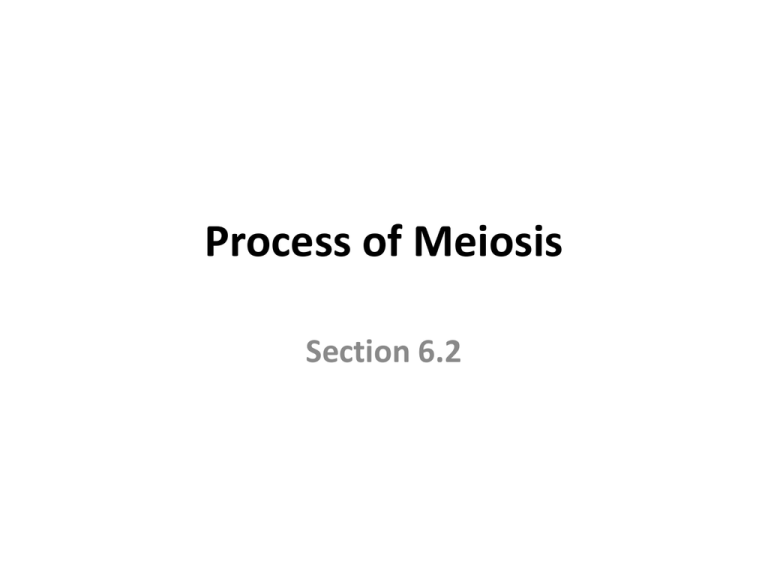Section 6.2: Process of Meiosis
advertisement

Process of Meiosis Section 6.2 Objectives • SWBAT compare and contrast the two rounds of division in meiosis. • SWBAT describe how haploid cells develop into mature gametes. Vocabulary • • • • Gametogenesis Sperm (spermatazoa) Egg (ovum) Polar body Meiosis Basics • Like mitosis, it is a form of nuclear division. • Unlike mitosis, meiosis has two rounds of nuclear division (mitosis has only one). – The divisions are called meiosis I and meiosis II. – Each round of cell division has four phases. • The product of meiosis is four haploid cells from one diploid cell. – Thus, meiosis is a reductive process. Meiosis Basics Homologous Chromosomes and Sister Chromatids • Homologous chromosomes are two separate, yet similar, chromosomes – one from your mother and one from your father. • Remember, homologous chromosomes are very similar since the have the same length and carry the same genes. • They are not copies of one another. • Sister chromatids, however, are genetically identical to one another. • A chromatid is half of a duplicated chromosome – both halves together are called sister chromatids. Sister chromatids refers to duplicated chromosomes that are attached at the centromere. Homologous Chromosomes and Sister Chromatids Homologous chromosomes are divided in meiosis I. Sister chromatids are not divided until meiosis II. Phases of Meiosis • Before meiosis begins, DNA has already been copied. • Meiosis I divides homologous chromosomes, producing two haploid cells with duplicated chromosomes (i.e. sister chromatids). Meiosis I • This figure is from p. 174 of your book Meiosis II • Meiosis II divides sister chromatids resulting in undoubled chromosomes. • Note: DNA is not copied again between these two stages. Meiosis II • This figure is from p. 175 in your book Differences between mitosis and meiosis • Meiosis has 2 cell divisions (mitosis only 1). • During meiosis, homologous chromosomes pair up along the cell equator, while homologous chromosomes never pair up in mitosis. • In anaphase I sister chromatids remain together while sister chromatids separate in anaphase of mitosis. • Meiosis results in haploid cells – mitosis diploid cells. Haploid Cells Become Mature Gametes • Once the haploid cells are produced by meiosis, they must go through gametogenesis (the production of gametes) to become mature gametes. • While meiosis is the same in males and females, the final stages of gametogenesis differs between the sexes – resulting in Sperm and Eggs (ova). Sperm • Sperm is much smaller than the egg. • Its contribution is its DNA (it does not contribute nutrients like the egg). • The haploid cell is altered to become streamlined and motile (moving with its tail). Ova (eggs) • The formation of an ovum is a more complex process than that for a sperm. • It actually begins inside of the developing body of a female embryo. – The process is characterized by periods of active development and log periods of inactivity. • An ovum not only gives its share of DNA but also contributes the organelles, molecular building blocks (Ex. amino and nucleic acids), and other materials an embryo needs to begin life. Ova (eggs) • Only on cell produced by each round of mitosis becomes an egg. The other cells become polar bodies. • All of the cytoplasm, organelles, and other molecular building blocks go to only one of the cells. The other three cells (the polar bodies) contain little more than DNA. They eventually are broken down by the female’s body.






